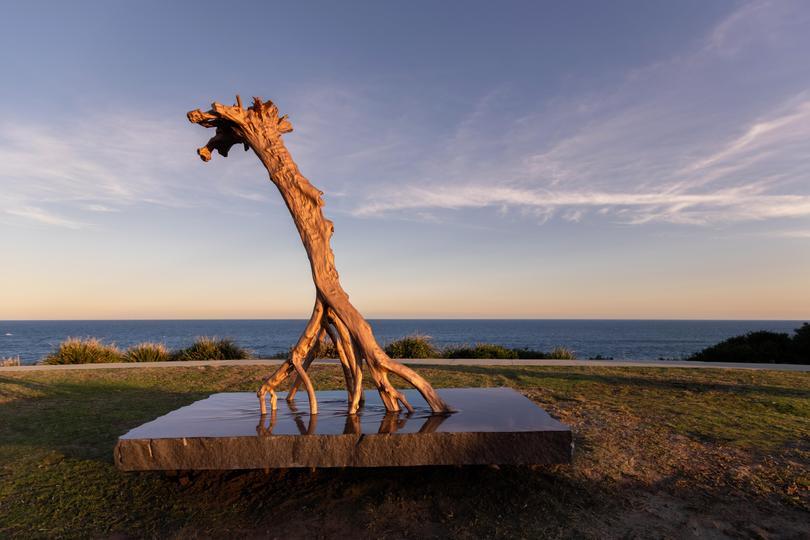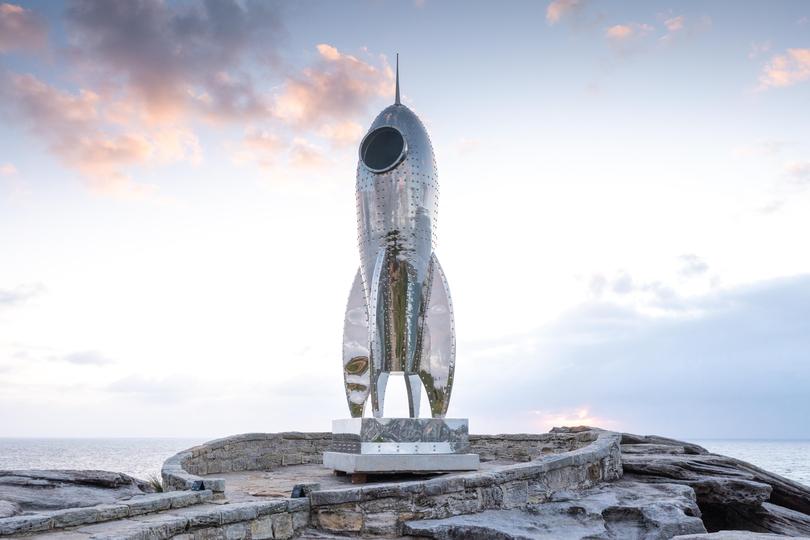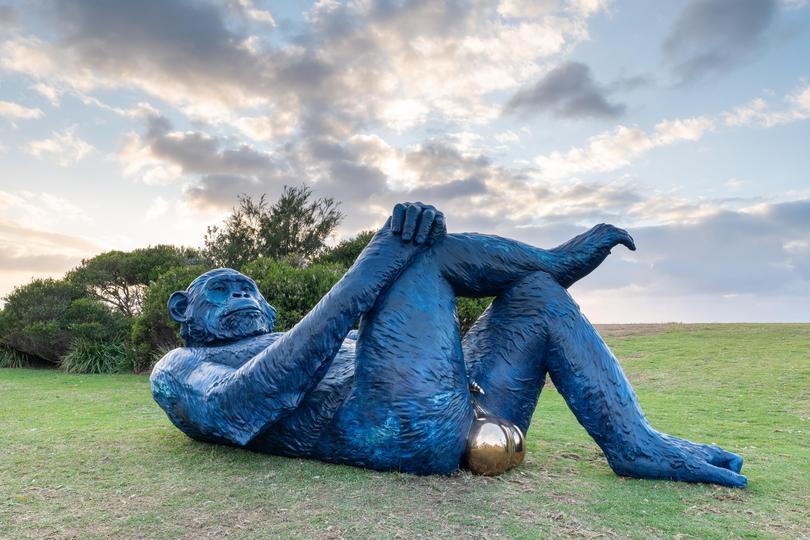Sydney Sculpture by the Sea 2024 review: John McDonald gives us the best of the annual art exhibition

For 27 years crowds have been surging along the Sydney foreshores between Bondi and Tamarama for Sculpture by the Sea. I was a selector, with sculptor, Ron Robertson-Swann, for the inaugural SXS in 1997 which was only a one-day affair. Even then the signs were ominous, with so many artists submitting entries it took all day to sift through them.
Since that first, slightly amateurish event, SXS has evolved into a highly professional organisation, responsible for annual exhibitions at Bondi and at Cottesloe in Perth, a permanent sculpture trail in the Snowy Mountains, and a raft of other projects scattered throughout the year. Bondi, however, is the mothership. It is now one of the biggest events on the Australian art calendar, with a level of popularity that leaves public art museums gasping. In previous outings the show has attracted more than half a million visitors, even allowing for October’s predictable wind and rain.
This year the two-kilometre sculpture circuit has been complicated by a rock fall that has closed part of the coastal walk, meaning that weekend visitors who arrive from the Tamarama end must leave Marks Park and make a lengthy detour around the block to arrive at the entrance to the show. SXS boss, David Handley, has become accustomed to wrangles with the Waverley Council, but this year his main enemy is nature, which has not only dropped a bomb on the walking path, but held up shipments of work with storms off the Indian coast.
Sign up to The Nightly's newsletters.
Get the first look at the digital newspaper, curated daily stories and breaking headlines delivered to your inbox.
By continuing you agree to our Terms and Privacy Policy.As usual, the 2024 show is a hodgepodge. From 100 items, there are a few standout pieces, a range of crowd-pleasing gimmicks, and many smaller works that struggle to define themselves against a backdrop of craggy rocks and surging waves. It will never please the cognoscenti, but the public doesn’t seem to mind. A gigantic blue chimpanzee with a golden scrotum, by French artist, Denis Defrancesco, is emerging as a clear favourite with visitors.
The chimp is a selfie magnet in a show full of photogenic moments. Find the right angle and the most banal sculpture is transformed into a masterpiece, artfully framed by sea and sky. There’s a queue of people eager to pose alongside a skinny-legged astronaut created by New Zealander, Milarky, while many a head has found its way into the mouth of a shark emerging from a banana peel, by local artist, Drew McDonald. Another NSW sculptor, Jane Gillings, has set up an old piano by the coastal walk, which seems to be in constant use, as visitors pause to play the popular classics.
Easily the most spectacular exhibit this year is Odyssey, by Queensland’s Clayton Blake, an eight-metre-tall stainless steel rocketship that looks as if it has been borrowed from a Hollywood B-movie. Blake has been granted the prime slice of real estate – the circular observation deck in at the foot of Marks Park. It requires a whopping sculpture to do justice to this location and this spaceship does the job with ease. Is it a great work of art? It would be better described as a great piece of showbusiness, to be admired for its chutzpah rather than its aesthetic refinements.
Like Jeff Koons, contemporary art’s king of kitsch, Blake has realised that sheer scale can transform something that looks like an ornament or a toy, into a monument. Or, as the artist himself puts it: “A celebration of the human spirit and our innate desire to explore, discover, travel and for adventure.” One can imagine an equally heroic legend attached to the Big Banana or any of the other roadside attractions that inspire such affection in Australian hearts. Perhaps Blake’s big spaceship might find a permanent home on a lonely road to the Woomera rocket range.

The judges for this year’s $100,000 Acqualand Sculpture Award, were not seduced by that shiny surface, giving the prize to Chinese artist, Shen Lieyi, for Tracing - a bronze sculpture of a tree trunk, its base divided into long roots, buried in a granite base made to look like a slippery, muddy tidal flat. The artist tells us: “it symbolises looking back on the past, seeking origins and exploring the essence of things,” which is the kind of impeccably neutral explanation we’ve come to expect from Chinese artists. It could just as easily be a symbol for a battered and bruised individual hanging on, half-dead, against the tides of history.
Although its craftsmanship is immaculate, Tracing is not an especially engaging work. Its figurative qualities are subordinated to an almost photographic sense of realism, and its tree symbolism is not wildly original. Yet when one tries to nominate a more appropriate choice the judges’ dilemma becomes clear. For while there are strong entries by previous winners such as Tony Davis, Stephen King, Orest Keywan and John Petrie, there’s a feeling of familiarity about these pieces. The same might be said for the works of the two best sculptors yet to win the prize - James Rogers and Philip Spelman.

In an ideal world the judges would make ruthlessly objective decisions, awarding prizes solely on the basis of merit. In reality, they weigh up those things they already know against new experiences, searching for a crucial point of distinction. In this year’s selection, Shen Lieyi’s work looks different enough to stand out from the crowd, and serious enough not to be dismissed as a novelty.
They might have considered Justene Williams’s rough and ready, Glittering Principle - Sydney Sheila, an antipodean cousin to Boccioni’s Unique Forms of Continuity in Space (1913); or Kaoru Matsumoto’s elegant Cycle-90 degrees, Wind of the Sea, but the former might have been a little too crude, the latter a touch too refined.
A special feature of this year’s show is a group of twelve works by ten artists from India and the Indian diaspora. I wish I could report these contributions were uniformly impressive, but most of them are smallish in scale and do not relate well to the landscape setting, being better suited to enclosed spaces. The obvious exception is Ayesha Singh’s Hybrid Drawing, a double silhouette of a typically Indian building made from thin strips of aluminium. It’s a simple frame through which we view the ocean.

Subodh Kerker has played up to the Indian ‘theme’ with a sculpture of an oversized red chilli, although it would need to be considerably larger to command more than a passing glance.
One peculiarity of this year’s SXS is the number of artists who are referred to as “Dr” or “Professor”, as if an official title served as a guarantee of talent. Perhaps I have an overly sceptical attitude towards academe, but I’ve always found that when it comes to making art the only advantage the professors enjoy is that they’re more influential and better connected. The superior artist will always stand out, regardless of degrees and titles which have more to do with the reality of careers than the mysteries of creativity.
Ultimately, as “Dr” Richard Tipping informs us in a sign posted by the coastal walk, “Reality is for people who can’t cope with art.”
Sculpture By the Sea 2024
Bondi to Tamarama
Until 4 November
John McDonald is one of Australia’s best-known and respected art critics, having spent more than 40 years reviewing visual arts, fashion, film, journals, and books. McDonald was the senior art critic for The Sydney Morning Herald for 41 years and was also well known for his weekly film column in that time. He has also worked as the Head of Australian Art at the National Gallery of Australia.
